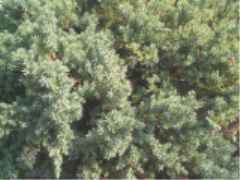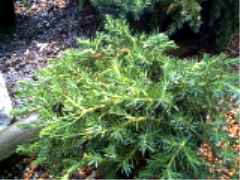|
|
 |
 |
|
Similar to stiff, needled foliage of "Blue Rug" Juniper |
with soft, long needles |
|
|
 |
 |
|
Similar to stiff, needled foliage of "Blue Rug" Juniper |
with soft, long needles |
Creeping junipers are very useful as ground covers for slopes located in the full sun. Often we have open banks that are so steep that they are dangerous to mow. Erosion can also be a problem when attempting to grow grass on such an embankment. The sunny embankment is one of the more challenging areas in the landscape. The slope provides drainage, which is usually conducive to drought. The erosion also means most of the topsoil and organic matter has long since washed off of the slope into a ditch that transports the soil away to lower ground. Other good ground covers include ivy, periwinkle, pachysandra, and ajuga. Of these, only the ajuga would enjoy the sun. For these reasons, we frequently use junipers on steep banks.
There are hundreds of varieties of junipers. Some commonly used varieties of spreading junipers are the “shore” juniper (Juniperus conferta), “Blue Pacific” juniper (Juniperus conferta “Blue Pacific”), “Blue Rug” juniper (Juniperus horizontalis “Wiltonii”), and “Prince of Wales” juniper (Juniperus horizontalis “Prince of Wales”).
The “shore” juniper has pretty ceded the right of way to the “Blue Pacific” because of the blue foliage. One is green and one is blue, and most folks prefer the blue foliage because it provides a contrasting color to the traditional green foliage of most plants. I find this plant to be the most rapidly spreading of the junipers, producing complete cover within 3 or 4 years when planted at 4 foot centers. Its ½ inch long needles yield a soft texture, which I find to be quite appealing. Years ago we had this plant growing on the front fence line at the store and it began to climb the chain link fence. Vigorous to say the least!
The “Blue Rug” has short needles similar to those of the common Cedar. The plant tends to hug the ground tightly and creep out a branch at a time, much like a sprawling octopus. The appearance of this plant is very complimentary to Japanese gardens. While quite different fro the “shore” juniper, the appearance of the “Blue Rug” has a distinct and desirable appearance all its own. Planted at 3 foot centers, the plant will probably provide complete cover in 4 to 6 years.
The “Prince of Wales” juniper is almost as vigorous in its growth habit as the “shore” juniper. The gray/blue wavy foliage of the “Prince” provides yet another texture which is entirely different than that of its cousins. The plant grows more vigorously than the “Blue Rug” yet I would still space these plants at 3 foot centers for quick coverage.
The junipers are acid loving plants, which will grow to a dense mat. Cultural techniques include keeping the plants free of debris such as leaves, twigs, etc. Mature plants should be thinned occasionally in order to provide adequate air circulation. If allowed to become too dense, the plant will suffer from Phomopsis stem blight. This problem is initiated by periods of heavy rainfall. Once the blight occurs, it can be treated with a metallic fungicide such as “Mancozeb”, but the treatment is only effective if the rains stop and the gardener practices good hygiene – clean and thin! One final word of caution! Don’t assume you have good drainage just because you are planting on a slope. I’m off to my 25th high school reunion now. Have a good week.
Andy Lynn